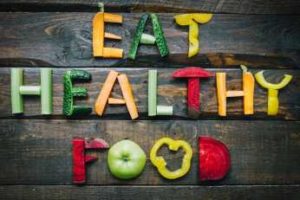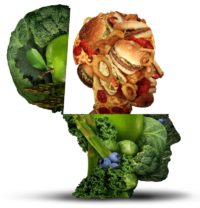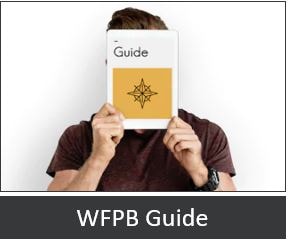The WFPB basics.

What is a Whole Food Plant-Based Diet?
This page explains all the basics around a whole food plant-based diet.
Do the best you can until you know better. Then when you know better, do better.
– Maya Angelou
Note: The information contained on this website should not be used in place of advice from a medical, nutrition or other professional. Please always consult with your doctor before adjusting your diet according to information provided on this website.
Contents
- What is a Whole Food Plant-Based Diet (WFPBD)?
- Whole Food Plant-Based vs. Vegan vs. Vegetarian
- Benefits of a Whole Food Plant-Based Diet
- The Protein and Calcium Myths
- Isn’t a WFPBD expensive?
- Isn’t a WFPBD lacking nutrients?
- Should I really avoid salt and oil?
- What role does a WFPBD play for the environment?
What is a Whole Food Plant-Based Diet (WFPBD)?
A whole food plant-based diet (WFPBD) consists of 100% plant-based and largely unprocessed or minimally processed foods.
A WFPBD includes no meat or fish, no animal-based products like eggs and milk, for example, and no processed or refined vegan foods such as white flour, added sugar or processed oils.
Compared to a vegan diet, there is no ethical component component to a WFPBD.
Let’s explore the two main pillars a bit more: Whole foods and plant-based foods.
Whole foods are foods that are whole, natural and not heavily processed. Only unrefined or minimally processed foods are allowed here. the closer to their natural state that foods are the better. Natural = whole.
Plant-based is easy to explain as the name implies it. These are foods based on plants mainly from the following whole food plant-based food groups: vegetables, fruits, legumes, whole grains and plant starches, nuts and seeds. These are the main groups but there are other (sub) groups like leaves, bulbs, roots, mushrooms, stems, flowers, etc. This, however, doesn’t mean that all these plant-based foods should be eaten in equal abundance – see recommendations below.
To summarize, here’s what defines a whole food plant-based diet:
- Whole, natrual, plant-based foods
- No animal products like meat, poultry, seafood, dairy, eggs, etc
- Unrefined or minimally processed foods
- No refined foods like white flour, white rice, white bread, white pasta, refined sugar / sweeteners, added sugar, processed oils (including olive, coconut, palm and canola oil), margarine, salt, sodium-high foods, refined grains, refined carbohydrates, saturated or trans fats, protein isolates, soda, fruit juice, sports drinks, energy drinks, etc.
- Organic foods, free of genetically modified organisms (aka non-GM or GMO-free), hormones, chemicals, pesticides, antibiotics, addiives, coloratns, preservatives.
- The following should be eaten in abundance:
- Vegetables
- Fruits
- Legumes
- Whole grains
- Greens
- Roots
- Seeds rich in Omega 3
- Spices
- Plant-based milks
- Green and herbal tea
- Decaf coffee
- The following should be eaten in moderation / sparingly:
- Nuts
- Seeds
- Dried fruits
- Nut and seed-based milks and butters
- Whole grain flour
- Whole grain bread
- Soy products like tofu, tempeh and miso
- Coconut
- Avocado
- Seeds not rich in Omega 3
- Added sweeteners
- Coffee, tea and alcohol
For an even more detailed overview, please check out T. Colin Campbell’s website listed below under “Resources” as the number 1 link where a lot of the bullets above were taken from.
In the WFPB foods section of this website, you’ll find a few exceptions that are listed although they are not recommended to be consumed if you’re following a strict WFPBD. The most prominent example there is olive oil. Therefore, for all the foods listed there, please come back and keep referring to this list to check which foods should be consumed in abundance vs. in moderation / sparingly vs. not. It is in your hands to combine the foods listed on this website in a way that works and is healthy for you.
When you go shopping for your WFPB foods, please always read the labels on the food products to ensure you’re only buying products with acceptable ingredients.
Whole Food Plant-Based vs. Vegan vs. Vegetarian
While vegetarian, vegan and whole food plant-based diets are similar, they are definitely not the same.
Vegetarian:
Vegetarians don’t eat any meat or fish but they consume pretty much any other foods like eggs, milk, grains, vegetables, etc.
Within the vegetarian spectrum, there are sub groups like the lacto-vegetarians and the ovo-vegetarians. The former don’t eat eggs but they consume dairy products and the latter eat eggs but they don’t consume dairy products. Also, there are pescatarians which are vegetarians that eat seafood but no meat. In addition to these main sub groups, there are many combinations such as vegetarians that eat eggs and fish but no dairy, dairy and fish but no eggs, etc. There’s also a group called the flexitarians who sometimes eat meat or seafood but mostly stick to a plant-based diet.
Vegan:
Vegans don’t consume any meat or fish but they also don’t consume any animal-based or animal-derived products like eggs, milk and honey, for example. They eat vegetables, fruits, legumes, grains, etc. but also (over)processed vegan foods. True veganism goes beyond a vegan diet and so a true vegan abstains from all animal products for ethical reasons. This extends to the clothes they wear, etc. But in reality, veganism is often used to describe a vegan diet and there are vegans who don’t abstain from animal products.
Whole Food Plant-Based (WFPB):
This diet consists of 100% plant-based and largely unprocessed or minimally processed foods like vegetables, fruits, legumes, grains, etc.
A whole food palnt-based diet (WFPBD) includes no meat or fish, no animal-based products like eggs and milk, for example, and no processed vegan foods.
Compared to a vegan diet, there is no ethical component component to a WFPBD.
In terms of plant-based diets, we distinguish between plant-based and whole food plant-based. It’s OK to consume oils (olive oil, etc.) and even highly processed foods (like bleached flour, refined sweeteners, white rice, etc.) as part of a plant-based diet whereas people who practice a whole food plant-based diet avoid these foods.
There is a school of thought that assumes that a whole food plant-based allows meat, poultry and fish. This is not a philosophy this website supports. Plant-based is plant-based only.
Comparison Table:
Below table summarizes above information in case it is a bit confusing.
| Diet Type | Whole Food Plant-Based |
Plant-Based | Vegan | Vegetarian | Lacto-Vegetarian | Ovo-Vegetarian | Pescatarian |
|---|---|---|---|---|---|---|---|
| Meat / Poultry | NO | NO | NO | NO | NO | NO | NO |
| Seafood | NO | NO | NO | NO | NO | NO | YES |
| Eggs | NO | NO | NO | NO | NO | YES | NO |
| Dairy | NO | NO | NO | NO | YES | NO | NO |
| Oils | NO | YES | YES | YES | YES | YES | YES |
| Highly Processed Foods | NO | YES | YES | YES | YES | YES | YES |
| Plants (Vegetables / Fruits / Legumes / Whole Grains / etc.) | YES | YES | YES | YES | YES | YES | YES |
Benefits of a Whole Food Plant-Based Diet
A whole food plant-based diet (WFPBD) has the potential to improve your overall life quality.
Here are some general areas where a WFPBD has proven to be very beneficial:
- Disease prevention and reversal
- Improve gut, mental and overall health
- Weight loss, weight gain prevention and weight management
- Improved athletic performance and increased energy levels
- Eat without counting calories
- Save money
- Help save the planet
- Save animals
(See resource 2 for above list.)
In terms of health benefits, it should be called out specifically that consuming less or no meat has the potential to help with the following:
- Reverse or prevent heart disease
- Reduce risk for certain chronic diseases
- Help prevent stroke
- Reverse or prevent obesity
- Lower blood pressure
- Lower blood sugar
- Lower cholesterol
- Lower type 2 diabetes risk
- Lower risk for many cancers
- Slow progression of certain cancer types
- Improve rheumatoid arthritis symptoms
- Better sleep
- Less inflammation
- Better skin, hair and nails
- Slow or prevent cognitive decline
(See resources 3, 4, 5, 6, 7, 8 for above list.)
The Protein and Calcium Myths
The false believe that we need meat and dairy to cover our protein and calcium needs is ingrained in a lot of people.
Be prepared to encounter it when you tell people you live a WFPB lifestyle.
Here’s the good news for you: The reality is that you really don’t need to worry because a WFPBD – if done correctly – will provide you with plenty of protein and calcium.
We recommend this article for some background on the protein side of things and this article or this article for calcium. This information will address any concers you may have and it will also allow you to discuss any concerns others may have with your WFPBD.
Isn’t a WFPBD expensive?
A lot of times, when websites refer to a whole food plant-based diet, you see expensive foods or meal packages that make you wonder if you can really afford this healthy lifestyle. Yes, you can! A lot of the basic fods of a WFPBD are among the most affordable ones. Examples for those include potatoes, beans, whole grains, etc. Imagine what you save by not eating meat any longer alone. If you build your WFPBD around those staples instead of mainly expensive imported fruits, you should be able to eat healthy while not exceeding your budget.
Also, as outlined by Dr. Greger on his website here, you have to think about cost in terms of cost per serving, cost per weight or cost per nutrition basis when it comes to a WFPBD. Dr. Campbell’s website also has a good article about this. Also, check out Dr. Greger’s three videos below which address the question.
Eating Healthy on the Cheap:
–
Eating Healthy on a Budget:
–
Superfood Bargains:
–
Isn’t a WFPBD lacking nutrients?
More good news: There’s no need to worry as a WFPBD provides you with almost all the basic nutrients your body needs.
The only nutrient where a supplement is required is vitamin B12. While WFPBD practitioners need to supplement their B12 intake, a lot of people actually lack B12 – regardless of their diet. Fortified foods like cereals, plant-based milks, soy milk or nutritional yeast, for example, have B12 but that isn’t enough and you’ll need some additional B12. Any other supplements can be seen as rather optional for most people unless there is a need. See this article for some good background and recommendations when it comes to supplementing your B12 intake.
Here’s also a good post about supplements in general.
And if you’re concerned about Omega 3, stop by here.
Should I really avoid salt and oil?
The short answer is “yes”.
For more information, check out this article about salt and this article about oil.
What role does a WFPBD play for the environment?
If you’d like to explore this topic further, WFPB.org’s Universal Guideline for Human & Planetary Health is the very best place to start.


